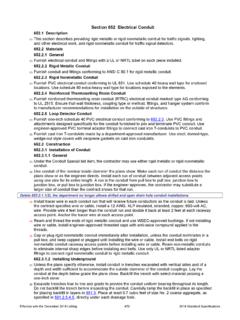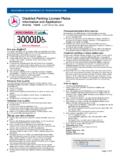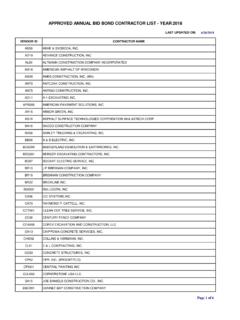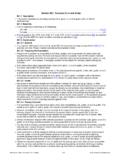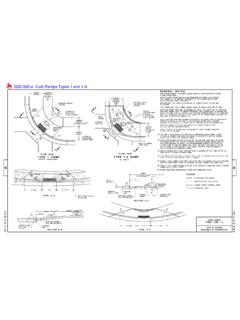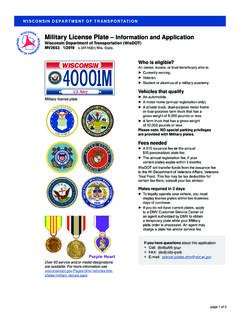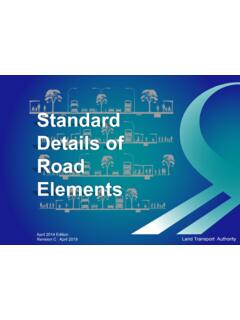Transcription of TRAFFIC IMPACT ANALYSIS GUIDELINES
1 2019 TRAFFIC IMPACT ANALYSIS GUIDELINES LAST UPDATED: MAY 2019 BUREAU OF TRAFFIC OPERATIONS TRAFFIC IMPACT ANALYSIS GUIDELINES TOC TABLE OF CONTENTS PREFACE .. A-1 IMPORTANT NOTICE .. B-1 TRAFFIC IMPACT ANALYSIS OUTLINE .. C- 1 LIST OF REQUIRED EXHIBITS .. D-1 APPENDICES .. E-1 CHAPTER 1 INTRODUCTION & EXECUTIVE SUMMARY .. 1-1 CHAPTER 2 PROPOSED DEVELOPMENT .. 2-1 CHAPTER 3 ANALYSIS OF EXISTING CONDITIONS .. 3-1 CHAPTER 4 PROJECTED TRAFFIC .. 4-1 CHAPTER 5 TRAFFIC AND IMPROVEMENT ANALYSIS .. 5-1 CHAPTER 6 CONCLUSIONS AND RECOMMENDATIONS .. 6-1 CHAPTER 7 DESIGN CONSIDERATIONS.
2 7-1 G-1 TABLE OF CONTENTS PREFACE A-1 BUREAU OF TRAFFIC OPERATIONS PREFACE TRAFFIC impacts and their potential need for mitigation are important for any community to consider with new development proposals. Public policy makers, citizens, and developers all have a stake in understanding and responding to additional demands on the transportation system. All share the common interest of a safe and efficient transportation network. A properly developed TRAFFIC IMPACT ANALYSIS can provide the factual basis for good decision-making and facilitate the timely implementation of effective mitigation measures.
3 A TRAFFIC IMPACT ANALYSIS (TIA) is a specialized engineering study that determines the potential TRAFFIC impacts of a proposed TRAFFIC generator. A TIA should answer the following fundamental questions: What are the existing TRAFFIC conditions, the expected future TRAFFIC conditions without the development, and the expected future TRAFFIC conditions with the development in place for all roadway users? Can the existing and planned multimodal transportation system accommodate the additional TRAFFIC generated by the planned development? Are there additional transportation needs, beyond those already programmed or included in the local transportation plan, required to maintain a satisfactory level of service (LOS)?
4 What are the recommended roadway improvements that may be necessary to accommodate the expected development TRAFFIC ? The TIA preparer shall complete the TIA prior to finalizing the development design, while there is still flexibility in the development s site design. Prior to obtaining any permits, the developer shall receive WisDOT s acceptance of the completed TIA. PURPOSE The purpose of this document is to establish uniform GUIDELINES for conducting TIA s for proposed new developments, the expansion of existing developments, and requests for new or modified access to the State Trunk Network (STN).
5 The GUIDELINES aim to ensure all studies contain the necessary information in a uniform format, providing the opportunity for an efficient review of the proposal s effect on the state highway. WisDOT is accountable for operating a safe and efficient state highway system. Proactive access management is vital in maintaining the overall safety and efficiency of this system. WisDOT manages access to the state highway system through statutes , , and and Administrative Rules Trans. 231 and Trans. 233. As part of the Wisconsin Department of Transportation s Access Permitting Procedure or the Trans. 233 review process, the regional office may require a TIA for proposed access requests.
6 Facilities Development Manual (FDM) procedure states, A TIA should be considered whenever TRAFFIC generated by the proposed development is expected to exceed 100 vehicles in the peak hour. Greater consideration should be given to requiring a TIA on an already congested or unsafe highway than on one with lower PREFACE TRAFFIC IMPACT ANALYSIS GUIDELINES A-2 TRAFFIC volumes and crash rates. Whenever WisDOT determines a TIA is necessary, the developer is required to provide it. Note that the acceptance of the TIA is not an approval of proposed recommendations outlined in the study, but an acknowledgment that the format of the TIA is acceptable for the department to review.
7 Typically, the regional TRAFFIC contact will provide a summary of the department s position and issues on the proposed recommendations outlined in the submitted TIA. The developer needs to address the region s issues prior to moving forward with the permitting process. TIA STUDY TIMEFRAME If a development will generate between 100 and 500 driveway trips in the peak hour, WisDOT has the option to require an abbreviated TIA instead of a full TIA. An abbreviated TIA focuses only on the base year TRAFFIC conditions with and without the development, whereas a full TIA analyzes both base and horizon year TRAFFIC conditions with and without the development.
8 A full TIA is typically more suitable for larger developments (greater than 500 peak hour vehicles) and requires involvement from the WisDOT forecasting team for horizon year TRAFFIC projections. The regional TRAFFIC contact will send a letter that identifies the need for an abbreviated or full TIA, defines the parameters of the study, and outlines the proposed study years. INITIAL REVIEW Prior to the submission of a full or abbreviated TIA, WisDOT may require preliminary TRAFFIC information for their use in developing the TIA parameters as part of the initial review process. Typically, WisDOT will inform the preparer of the need to complete an initial review during or shortly after preliminary development review meetings with WisDOT s planning and operations staff.
9 The initial review document shall, at a minimum, provide an overview of the proposed development plan, outline the existing transportation system, and highlight existing ADT volumes and expected trip generation of the proposed development. If required, the TIA preparer shall submit at least one hard copy of the initial review document. For additional information on the initial review process, contact the appropriate WisDOT regional TIA representative. IMPLEMENTATION OF TIA-REQUIRED IMPROVEMENTS Improvements required to mitigate operational or safety related TRAFFIC impacts caused by development are based on, but not limited to, the recommendations section of a TIA.
10 In response to the findings of the TIA, WisDOT will send a letter, memorandum, or email correspondence to identify the required development-driven improvements. These requirements are subject to WisDOT s authority and jurisdiction over any given highway. The mechanism for requiring TIA-related improvements is typically the permitting process ( , work on highway right-of -way, access, utility, etc.) overseen by the regional maintenance or planning units. Cited improvements and the methods for implementing them will become a condition of the permit. All improvements shall comply with current FDM policies.
